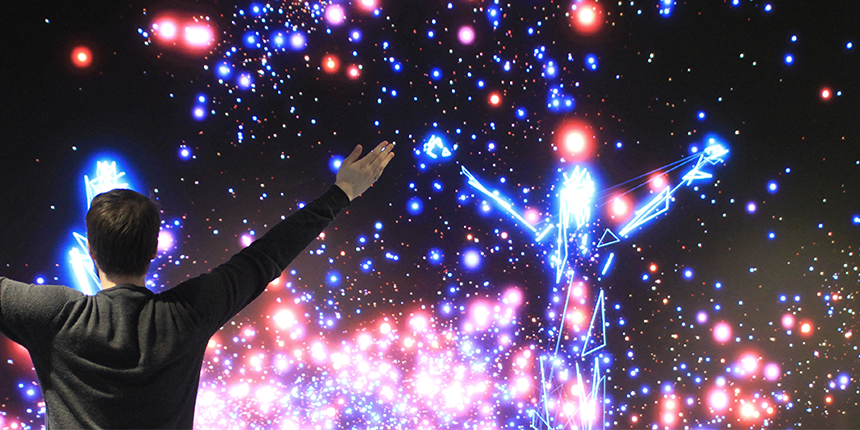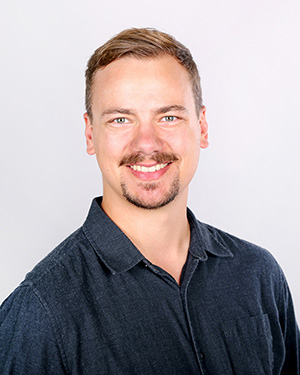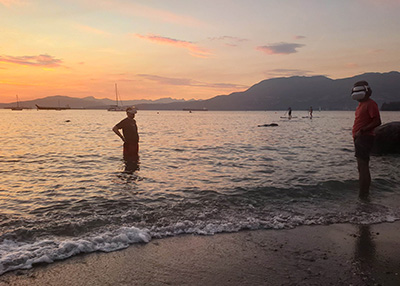
John Desnoyers-Stewart uses his engineering background to apply creative, artistic processes to his technological investigations, discovering new possibilities for transformative technology.

Photo by Tim Mah © 2023

With a P.Eng. and a degree in industrial systems engineering, John Desnoyers-Stewart found himself working in product development. He was constantly frustrated by situations where engineers were asked to solve problems when the company had already decided what solutions they wanted. There was no room for innovation or creativity. He found the situation stifling. It was this constraint that led Desnoyers-Stewart back to his artistic roots, looking for the spark he had left behind when he did his undergraduate degree. This time, when he embarked on his Master of Fine Arts in 2016, he made sure to combine his engineering expertise with his artistic endeavours, focusing on creative technology and computer science.
Now pursuing his Ph.D. in Interactive Arts and Technology at Simon Fraser University, Desnoyers-Stewart specializes in art installations made by combining creative art processes with engineering principles to explore the possibilities of transformative technology. As technology changes quickly, our ways of engaging with it transform as well. We use technology to communicate, to socialize, and to help us solve problems. Desnoyers-Stewart investigates this intersection between technological design and the lived experiences that it creates to pursue an approach to technology that fully explores its possibilities to reshape society while centering human connection.
Discovering the universe through a child’s eyes
The birth of Desnoyers-Stewart’s first child brought a completely new perspective to his work. “I was really inspired by seeing her discover the world,” he says. At the time he was looking to push the boundaries of what was possible in a virtual reality (VR) environment, and watching his daughter gave him the idea to explore the possibilities of a playful, interactive world.
“Star-Stuff was this really wonderful opportunity to just dive in and be really playful. I really just allowed my intuition to lead and allowed the design to just unfold. “The main concept began from a very abstract space: what would it be like to be a galaxy? To meet a galaxy?” From that notion, Star-Stuff was born. Star-Stuff: a way for the universe to know itself, as a VR program, allows you to occupy a galaxy, and interact with another stranger virtually, sharing a moment together to play with the stars in your orbits.
For a concept as ethereal and mind-bending as creating a body made of stars, the execution required a lot of science and engineering. The ratio of the types of stars—such as red giants, blue giants, and red dwarves—is accurate to the ratio found in our own galaxy, as is the stellar evolution of the stars. The experience is currently projection-based, so up to six children can play at a time. As they interact with the projections the stars will orbit around them and move based on their movements, an implicit and tactile lesson in gravity, only made possible by fluid dynamic simulations and simplified calculations that simulates the movement of tens of thousands of stars.
Star-Stuff has become one of Desnoyers-Stewart's most successful pieces, touring the world in multiple festivals before finding a home in 2022 at the H.R. MacMillan Space Centre, Vancouver, BC.
“It really helped to solidify some of the thoughts I had around how the creative process can work,” he says. “Something I've been trying to explore through my work is taking more of an open-ended approach to design, by following the design to see where it takes you.”
As he relates, the usual design method requires specifying what the end result should be before you begin. This leaves no room for exploration or innovation. By trusting the artistic process, Desnoyers-Stewart can find ways to push technology in totally new directions.
Breathing in sync
If Star-Stuff allows children to use VR and projections to experience movement in a new way, JeL could be seen as an example of creating an interactive, shared experience that requires almost no physical movement at all. Originally, JeL was a combination of VR and biofeedback technology that allowed someone to control virtual jellyfish via their breathing pattern. When two or more people breathed in sync, they could grow a virtual coral reef.
Synchronization, for an engineer, is very specific. You need to synchronize the phase, the frequency, and the amplitude for a completely synchronized experience. For an actual person, of course, this definition doesn’t work at all.
“People with different body types are going to be breathing at different rates, even if it’s slight, or at different amplitudes. And what feels comfortable and relaxing for one person can potentially not be for another,” Desnoyers-Stewart explains.
A new breathing synchronization project is being created in collaboration with the University of British Columbia’s engineering physics students as their capstone project. One team is working on designing ‘breathing chairs’ that will connect to the internet and allow people within the chairs to synchronize their breathing from anywhere in the world.
“A lot of this work is centered around social connection. There’s a lot of research that shows that synchronizing with another person can create this sense of connection,” says Desnoyers-Stewart.
Social connection and integration are integral to his work.
“We need to explore more into how we can integrate our experience with the real world and the virtual world in order to experience the real world in a new way.” Working with the capstone project, Desnoyers-Stewart has the opportunity to teach students not only how to bridge disciplines, but to consider the implications of their work that goes beyond calculations. The end design of the project is not simply the product—the chair itself—but the kind of experience the chair will create for its users.
“It’s really nice for the students to learn just how variable individual experiences can be and to understand the connection between something that's really concrete and tangible, like the size of a pipe, and the actual experience that creates for someone. We're working with them to better understand the design system and make that connection between the mechanical and the lived experience.”
This topic is one that Desnoyers-Stewart would like the public to engage in as well. Technology affects people’s lives, their bodies, and their relationships. He’d like people to reflect on how they use technology and how it impacts them in return.
Seeing sound through new eyes
One of the avenues Desnoyers-Stewart's work is constantly exploring is the ways in which technology can create a shared, lived experience, as opposed to one that is isolated or virtual only. Synedelica is an ongoing project where participants can explore the real world in new ways through VR. The visuals of the program are created by the soundscape around the person. Low frequencies are shown as shadows and high frequencies as highlights transforming their perception of reality.

“You can imagine it as a... display of different frequency bands, the same thing that you’d see in a fancy 90’s car stereo,” Desnoyers-Stewart says.
In a music festival, Syndelica creates an utterly unique, visual, sonar experience. “I actually went to a music festival and I took the headset there and handed it out, and people just handed it to one another and shared it socially. And when I saw that it wasn't just about the social experience in the headset, but it was also the sharing of the experience, for me that totally transformed the concept of what's possible with that technology.”
Desnoyers-Stewart plans on taking it to more music festivals in the future. He’s working with a team of artists, performers, and costume designers to see how the experience can be enhanced and shared. He’s also working with a deaf flow artist to see if Synedelica can be used to create an accessible music festival experience for deaf and hard of hearing people.
Ethics and exploration
This type of exploration and engagement is crucial to what Desnoyers-Stewart wants to accomplish with his work.
“There's a sort of a critical engagement that you often go through when you're creating an artwork and you deeply understand the technology. You often engage quite deeply with the ethics and the potential impacts.”
The biggest challenge facing engineers, he believes, is the potential erosion of responsibility in the engineering profession.
“This idea of ‘move fast and break things.’ We can’t afford that kind of attitude with things that affect our daily life and the way we interact with one another,” Desnoyers-Stewart says.
To Desnoyers-Stewart, there is nothing inherently good or bad about technology—it depends on how that technology is used. Engineers, as licensed, regulated professionals, have a strong ethical commitment and understanding, one that he would like to see emulated by other careers, particularly new ones that intersect with engineering, such as AI or software development.
Engineering itself is changing rapidly and dramatically. As an artist, Desnoyers-Stewart believes increased diversity, new perspectives, and interdisciplinary projects represent a positive change for the profession. Engineering should embrace these changes and be flexible and open to change while keeping to the core of their ethos: “The code of ethics forms the backbone of what it means to be in engineering, especially in Canada where it is really key to the profession.”
He counsels new engineers to keep their horizons broad, to recognize the value of their own diverse talents, and to see how they might integrate those talents to contribute and improve the engineering profession.
Star-Stuff is also available for the Meta Quest VR headset on AppLab. To see more of John Desnoyers-Stewart’s work, check out his bio.
Engineers build more than just bridges. Building Tomorrows is a series that highlights the important contributions of engineers and the many ways they help to make our world a better place.


